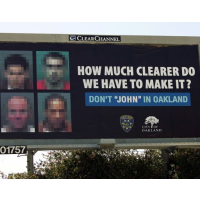L.A. County Plans to Join In on the Public Shaming of Johns
 (photo: Ben Margot, Associated Press)
(photo: Ben Margot, Associated Press)
Los Angeles County plans to launch an assault on sex trafficking by joining the statewide movement to resurrect puritanical public shaming of men willing to pay money for sex.
The county Board of Supervisors voted unanimously to have attorneys draft a plan for publicizing at least the names of men convicted of soliciting a prostitute. Supervisor Don Knabe envisioned posting pictures of Johns on the Internet and billboards, and newly-elected Supervisor Sheila Kuehl said public shaming was probably as effective now as it was 1,000 years ago, according to the Los Angeles Times.
Maybe more so. They didn’t have the Internet in 1014 A.D. when King Brian Boru of Ireland defeated the Vikings at Battle of Clontarf and freed his country.
Online shaming of shameless trolls and other evil doers, sometimes in righteous causes, has proliferated despite some disastrous consequences. Activist hackers like Anonymous have wreaked havoc on targets but shaming has been trending since at least 2007 and has been a staple of popular websites like Gawker since around 2012.
Shaming has a long history of official use—scarlet “A”s and the stocks, for example—that precedes the Internet, although many practices have fallen out of favor over the years. Still, government continues to nurture other forms of shaming, constrained only by their creativity and budgets.
A number of California cities have tried to discourage prostitution, usually in the name of protecting underage children, immigrants and others trapped in the sex industry. Oakland has a webpage devoted to mugshots of suspected pimps and purchasers. They don’t have to be convicted of a crime or even charged to earn 15 days of fame. A simple arrest will suffice.
The Fresno Police Department’s “Operation Reveal” posts photos and information about people arrested for loitering with the intent to patronize a prostitute. They don’t need to be convicted of a crime. Their mugshots stay up for 15 days.
The Times said Richmond had abandoned its plan to shame Johns using Facebook, but the Richmond Standard said police denied that. Richmond tried posting mugshots on Facebook of people arrested, but helpful readers posted additional personal information about them, like where they worked and lived. But instead of mothballing the site, the police are removing content after 72 hours.
The Orange County district attorney pulls together information on convicted Johns from a bunch of participating cities for his “Sex Purchasers” website. The mugshots stay up indefinitely and those accused perps for whom there is no available pictures are listed on a separate page.
San Bernardino County has been humiliating men in public since April. Mugshots of the newly convicted are posted on “Stop the John” for a year.
California was at the forefront of using new technology to shame Johns in 1998 when Stockton’s city cable television station debuted “Vice TV,” one of the few shows in the nation that aired mug shots, names and arrest dates of convicted prostitutes and their Johns. At the time, San Joaquin County public defender Jerry Gleeson told the Times it was “pretty pathetic. . . . I'm not very comfortable with this idea of holding people up to ridicule. I don't see the value in it.”
But the rest of Stockton did and the show, with photos and names of convicted Johns, can be seen on Channel 97 on the 1st through the 7th day of each month.
The Times editorial board railed against the indignity and unproven effectiveness of public shaming this week, especially of people who have been accused of a crime, but not convicted. “It's simply deterrence-by-humiliation, and that's a practice that we gave up long ago.”
Uh, not really.
–Ken Broder
To Learn More:
L.A. County Plans to Shame “Johns” Who Solicit Prostitutes (by Abbey Sewell, Los Angeles Times)
The Problem with Public Shaming (by Cole Stryker, The Nation)
The Internet's Vigilante Shame Army (by Whitney Phillips and Kate Miltner, The Awl)
Orange County Prostitution Fight Puts New Focus on Shaming of Johns (by Emily Foxhall, Los Angeles Times)
- Top Stories
- Controversies
- Where is the Money Going?
- California and the Nation
- Appointments and Resignations
- Unusual News
- Latest News
- California Forbids U.S. Immigration Agents from Pretending to be Police
- California Lawmakers Urged to Strip “Self-Dealing” Tax Board of Its Duties
- Big Oil’s Grip on California
- Santa Cruz Police See Homeland Security Betrayal in Use of Gang Roundup as Cover for Immigration Raid
- Oil Companies Face Deadline to Stop Polluting California Groundwater




